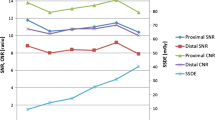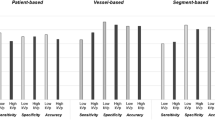Summary
The influence of low tube voltage in dual source CT (DSCT) coronary artery imaging on image quality and radiation dose and its application value in clinical practice were investigated. Totally, 300 cases of chest pain with low body mass index (BMI <18.5 kg/m2) subjected to DSCT coronary artery imaging were prospectively enrolled. The heart rate in all patients were greater than 65/min. The retrospective ECG gated scanning mode and simple random sampling method were used to assign the patients into groups A, B and C (n=100 each). The patients in groups A, B and C experienced 120-, 100-, and 80-kV tube voltage imaging respectively, and the image quality was evaluated. The CT volume dose index (CTDIvol) and dose length product (DLP) were recorded, and the effective dose (ED) was calculated in each group. The image quality scores and radiation doses in groups were compared, and the influence of tube voltage on image quality and radiation dose was analyzed. The results showed that the excellent rate of image quality in groups A, B and C was 95.69%, 94.72% and 96.33% respectively with the difference being not statistically significant among the three groups (P>0.05). The CTDIvol values in groups A, B and C were 51.35±12.21, 21.28±7.13 and 6.34±3.34 mGy, respectively, with the difference being statistically significant (P<0.05). The ED values in groups A, B and C were 9.27±1.63, 4.56±2.29 and 2.29±1.69 mSv, respectively, with the difference being statistically significant (P<0.05). It was suggested that for the patients with low BMI, the application of DSCT coronary artery imaging with low tube voltage can obtain satisfactory image quality, and simultaneously, significantly reduce the radiation dose.
Similar content being viewed by others
References
Achenbach S, Anders K, Kalender WA. Dual-source cardiac computed tomography: image quality and dose considerations. Eur Radiol, 2008,18(6):1188–1198
Stephan A, Ulrike R, Axel K, et al. Randomized comparison of 64-slice single and dual-source computed tomography coronary angiography for the detection of coronary artery disease. J Am Coll Cardiol, 2008,1(2):177–186
Mayo JR, Leipsic JA. Radiation dose in cardiac CT. AJR, 2009,192(3):646–653
Vavere AL, Arbab-Zadeh A, Rochitte CE, et al. Coronary artery stenoses: accuracy of 64-detector row CT angiography in segments with mild, moderate, or severe calcification—a subanalysis of the CORE-64 trial. Radiology, 2011,261(1):100–108
Austen WG, Edwards JE, Frye RI, et al. A reporting system on patients evaluated for coronary artery disease report of the Ad Hoc Committee for Grading of Coronary Artery Disease council on cardiovascular surgery, American Heart Association. Circulation, 1975,51(4):5–40
Raff GL. Radiation dose from coronary CT angiography: five years of progress. J Cardiovasc Comput Tomogr, 2010,4(6):365–374
Andreini D, Pontone G, Mushtaq S, et al. A long-term prognostic value of coronary CT angiography in suspected coronary artery disease. J Am Coll Cardiol Imag ing, 2012,5(7):690–701
Hausleiter J, Meyer T, Hadamitzky M, et al. Non-invasive coronary computed tomographic angiography for patients with suspected coronary artery disease: the Coronary Angiography by Computed Tomography with the Use of a Submillimeter Resolution (CACTUS) trial. Eur Heart J, 2007,28(24):3034–3041
Brenner DJ, Hall EJ. Computed tomography-an increasing source of radiation exposure. N Engl J Med, 2007,357(22):2277–2284
Wintersperger BJ, Nikolaou K, von Ziegler F, et al. Image quality, motion artifacts, and reconstruction timing of 64-slice coronary computed tomography angiography with 0.33-second rotation speed. Invest Radiol, 2006,41(5):436–442
Stolzmann P, Scheffel H, Schertler T, et al. Radiation dose estimates in dual-source computed tomography coronary angiography. Eur Radiol, 2008,18(3):592–599
Dewey M, Vavere AL, Arbab-Zadeh A, et al. Patient characteristics as predictors of image quality and diagnostic accuracy of MDCT compared with conventional coronary angiography for detecting coronary artery stenoses: CORE-64 multicenter international trial. Am J Roentgenol, 2010,194(1):93–102
Bischoff B, Hein F, Meyer T, et al. Comparison of sequential and helical scanning for radiation dose and image quality: results of the prospective multicenter study on radiation dose estimates of cardiac CT angiography (PROTECTION) I study. 2010,194(6):1495–1499
Zhang S, Levin DC, Halpern EJ, et al. Accuracy of MDCT in assessing the degree of stenosis caused by calcified coronary artery plaques. AJR, 2008,191(6):1676–1683
Hausleiter J, Meyer TS, Martuscelli E, et al. Image quality and radiation exposure with prospectively ECG-triggered axial scanning for coronary CT angiography: the multicenter, multivendor, randomized PROTECTION-III study. J Am Coll Cardiol Imaging, 2012,5(5):484–493
Kitagawa K, George RT, Arbab-Zadeh A, et al. Characterization and correction of beam-hardening artifacts during dynamic volume CT assessment of myocardial perfusion. Radiology, 2010,256(1):111–118
Sun Z, Ng KH. Prospective versus retrospective ECG-gated multislice CT coronary angiography: a systematic review of radiation dose and diagnostic accuracy. Eur J Radiol, 2012,81(2):e94–e100
Ong TK, Chin SP, Liew CK, et al. Accuracy of 64-row multidetector computed tomography in detecting coronary artery disease in 134 symptomatic patients: influence of calcification. Am Heart J, 2006,151(6):1323.e1–6
Muenzel D, Noel PB, Dorn F, et al. Step and shoot coronary CT angiography using 256-slice CT: effect of heart rate and heart rate variability on image quality. Eur Radiol, 2011,21(11):2277–2284
Gottlieb I, Miller JM, Arbab-Zadeh A, et al. The absence of coronary calcification does not exclude obstructive coronary artery disease or the need for revascularization in patients referred for conventional coronary angiography. J Am Coll Cardiol, 2010,55(7):627–634
Leschka S, Stolzmann P, Schmid FT, et al. Low kilovoltage cardiac dual-source CT: attenuation, noise, and radiation dose. Eur Radiol, 2008,18(9):1809–1817
Raff GL, Gallagher MJ, O’Neill WW, et al. Diagnostic accuracy of noninvasive coronary angiography using 64-slice spiral computed tomography. J Am Coll Cardiol, 2005,46(3):552–557
Hausleiter J, Martinoff S, Hadamitzky M, et al. Image quality and radiation exposure with a low tube voltage protocol for coronary CT angiography results of the PROTECTION IITrial. J Am Coll Cardiol Imaging, 2010,3(11):1113–1123
Miller JM, Rochitte CE, Dewey M, et a1. Diagnostic performance of coronary angiography by 64-row CT. N Engl J Med, 2008,359(22):2324–2336
Matin D, Nelson RC, Schindera ST, et al. Low-tube-voltage, high-tube-current multidetector abdominal CT: improved imaging quality and decreased radiation dose with adaptive statistical iterative reconstruction algorithm-initial clinical experience. Radiology, 2010,254(1):145–153
Stephan A, Ulrike RS, Axel K, et al. Randomized comparison of 64-Slice single- and dual-source computed tomography coronary angiography for the detection of coronary artery disease. J Am Coll Cardiol, 2008,1(2): 177–186
Szucs-Farkas Z, Kumam L, Strautz T, et al. Patient exposure and image quality of low-dose pulmonary computed tomography angiography: comparison of 100 and 80-kVp protocols. Invest Radiol, 2008,43(12):871–876
Meijboom WB, Van Mieghem CA, van Pelt N. Comprehensive assessment of coronary artery stenoses: computed tomography coronary angiography versus conventional coronary angiography and correlation with fractional flow reserve in patients with stable angina. J Am Coll Cardiol, 2008,52(8):636–643
Abada HT, Larchez C, Daoud B, et al. MDCT of the coronary arteries: feasibility of low-dose CT with ECG-pulsed tube current modulation to reduce radiation dose. AJR, 2006,186(6 suppl 2):S387–S390
Pflederer T, Rudofsky L, Ropers D, et al. Image quality in a low radiation exposure protocol for retrospectively ECG-gated coronary CT angiography. AJR, 2009,192(4):1045–1050
Pijls NH, Fearon WF, Tonino PA. Fractional flow reserve versus angiography for guiding percutaneous coronary intervention in patients with multivessel coronary artery disease: 2-year follow-up of the FAME study. J Am Coll Cardiol, 2010,56(3):177–184
Nissen SE, Tuzcu EM, Schoenhagen P. REVERSAL Investigators Effect of intensive compared with moderate lipid-lowering therapy on progression of coronary atherosclerosis: a randomized controlled trial. JAMA, 2004,291(9):1071–1080
Leipsic J, LaBounty TM, Heilbron B. Adaptive statistical estimated radiation dose reduction using adaptive statistical iterative reconstruction in coronary CT angiography: the ERASIR study. AJR, 2010,195(3):655–660
Min JK, Shaw LJ, Devereux RB. Prognostic value of multidetector coronary computed tomographic angiography for prediction of all-cause mortality. J Am Coll Cardiol, 2007,50(12):1161–1170
Ho KT, Chua KC, Klotz E, et al. Stress and rest dynamic myocardial perfusion imaging by evaluation of complete time-attenuation curves with dual-source CT. J Am Coll Cardiol Iamging, 2010,3(8):811–820
Author information
Authors and Affiliations
Corresponding author
Additional information
This project was supported by the Natural Science Foundation of Hubei Province, China (No. 2012FKB02443).
Rights and permissions
About this article
Cite this article
Lei, Zq., Han, P., Xu, Hb. et al. Correlation between low tube voltage in dual source CT coronary artery imaging with image quality and radiation dose. J. Huazhong Univ. Sci. Technol. [Med. Sci.] 34, 616–620 (2014). https://doi.org/10.1007/s11596-014-1326-9
Received:
Revised:
Published:
Issue Date:
DOI: https://doi.org/10.1007/s11596-014-1326-9




